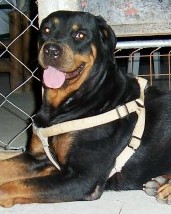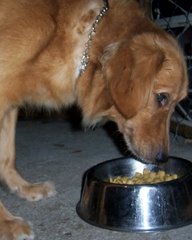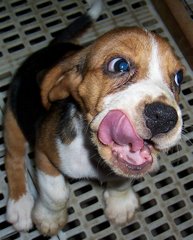 WHAT IS IT?
WHAT IS IT?
Kennel cough is a bronchitis characterized by a harsh, hacking cough which most people describe as sounding like “something stuck in my dog’s throat.” It is analogous to a chest cold for humans and is only a serious condition in special circumstances (see below); in general, it resolves on its own..
HOW INFECTION OCCURS?
 The normal respiratory tract has substantial safeguards against invading infectious agents. The most important of these is probably what is called the “mucociliary escalator.” This safeguard consists of tiny hairlike structures called cilia, which protrude from the cells lining the respiratory tract, and a coat of mucus over them. The cilia beat in a coordinated fashion. Debris, including infectious agents, get trapped in the sticky mucus and the cilia move the mucus upward towards the throat where the collection of debris and mucus may be coughed up and/or swallowed.
The normal respiratory tract has substantial safeguards against invading infectious agents. The most important of these is probably what is called the “mucociliary escalator.” This safeguard consists of tiny hairlike structures called cilia, which protrude from the cells lining the respiratory tract, and a coat of mucus over them. The cilia beat in a coordinated fashion. Debris, including infectious agents, get trapped in the sticky mucus and the cilia move the mucus upward towards the throat where the collection of debris and mucus may be coughed up and/or swallowed.
The mucociliary escalator is damaged by the following:
- shipping stress
- crowding stress
- heavy dust exposure
- cigarette smoke exposure
- infectious agents (viruses such as reovirus, adenovirus, parainfluenza virus, and even the distemper virus can be initiating infections)
- Cold temperature
- Poor ventilation
Without this protective mechanism, invading bacteria, especially Bordetella bronchiseptica may simply march down the airways unimpeded.
Bordetella bronchiseptica has some tricks of its own as well:
- It is able to bind directly to cilia, rendering them unable to move within 3 hours of contact.
- It secretes substances that disable the immune cells normally responsible for consuming & destroying bacteria
Because it is common for Bordetella to be accompanied by at least one other infections agent (such as one of the viruses listed above), “Kennel Cough” is actually a complex of infections, rather than infection by one agent.
Classically, dogs get infected when they are kept in a crowded situation with poor air circulation but lots of warm air (i.e. a boarding kennel, vaccination clinic, obedience class, local park, animal shelter, animal hospital waiting room, or grooming parlor). In reality, most causes of coughing that begin acutely in the dog are due to infectious causes and usually represent some form of Kennel Cough.
THE INCUBATION PERIOD IS 2 - 14 DAYS
HOW CONTAGIOUS IS IT?
Bordetella infection can be picked up by rabbits, guinea pigs, pigs, cats (if they are very young and housed in groups), and other dogs. It is not contagious to humans though it is closely related to Bordetella pertussis, the agent of Whooping Cough. Among dogs it is fairly contagious depending on stress level, vaccination status, and exposure to minor viruses.
Our hospital recommends keeping all dogs current on their Bordetella vaccinations as you never know when they be in an unexpected situation
HOW IS IT TREATED?
Although most cases will go away on their own, we like to think we can hasten recovery with antibiotics to directly kill the Bordetella organism. Alternatively, Kennel Cough may be treated with cough suppressants to provide comfort during natural recovery. Or antibiotics and cough suppressants can be combined.
WHEN IS IT A SERIOUS CONDITION?
In very young puppies, especially those with a recent shipping history (i.e. pet store puppies) are especially prone to severe cases of infectious tracheobronchitis (frequently progressing to pneumonia).
In dogs where the distemper virus is involved (usually shelter or pet store puppies), there is tremendous potential for serious consequences. (For more information on distemper, click here)
VACCINATION OPTIONS:
There are basically two options for Kennel cough vaccination: injectable and intranasal.
Injectable is a good choice for aggressive dogs, who may bite if their muzzle is approached. It provides good systemic immunity as long as two doses are given after age 4 months (with an annual booster). Injectable vaccination may only lead to less severe infection and not complete prevention.
Intranasal vaccination may be given as early as 2 weeks of age and immunity generally lasts 10-12 months. (Usually this vaccine is boosted annually.) The advantage here is that the local immunity is stimulated, right at the site where the natural infection would be trying to take hold.
It takes 4 days to generate a solid immune response after intranasal vaccination so it is best if vaccination is given at least 4 days prior to the exposure. Some dogs will have some sneezing or nasal discharge in the week following intranasal vaccination. As a general rule, nasal vaccination provides faster immunity than injectable vaccination.
Parainfluenza, Adenovirus type 2, and canine distemper, all members of the Kennel Cough complex, are all covered by the standard DHLPP vaccine, the basic vaccine for dogs. Adenovirus Type 2 serum also immunizes against Adenovirus Type 1, the agent of infectious canine hepatitis.
VACCINATION IS NOT USEFUL IN A DOG
ALREADY INCUBATING KENNEL COUGH
WHAT IF IT DOESN’T IMPROVE?
As previously noted, this infection is generally self-limiting. It should be at least improved partially after one week of treatment. If no improvement has been observed in this time, a re-check exam (possibly including radiographs of the chest) would be a good idea.SOURCE: www.maristavet.com





2 comments:
I really appreciate you for all the valuable information that you are providing us through your blog.
Dog Kennels
Very cool idea! Thanks for posting this.
Really its amazing information about dog kennels for sale
Awesome job !!! well done keep it up.
Post a Comment